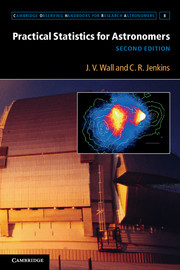Book contents
- Frontmatter
- Contents
- Dedication
- Foreword to first edition
- Foreword to second edition
- Note on notation
- 1 Decision
- 2 Probability
- 3 Statistics and expectations
- 4 Correlation and association
- 5 Hypothesis testing
- 6 Data modelling and parameter estimation: basics
- 7 Data modelling and parameter estimation: advanced topics
- 8 Detection and surveys
- 9 Sequential data – 1D statistics
- 10 Statistics of large-scale structure
- 11 Epilogue: statistics and our Universe
- Appendix A The literature
- Appendix B Statistical tables
- References
- Index
10 - Statistics of large-scale structure
Published online by Cambridge University Press: 05 June 2012
- Frontmatter
- Contents
- Dedication
- Foreword to first edition
- Foreword to second edition
- Note on notation
- 1 Decision
- 2 Probability
- 3 Statistics and expectations
- 4 Correlation and association
- 5 Hypothesis testing
- 6 Data modelling and parameter estimation: basics
- 7 Data modelling and parameter estimation: advanced topics
- 8 Detection and surveys
- 9 Sequential data – 1D statistics
- 10 Statistics of large-scale structure
- 11 Epilogue: statistics and our Universe
- Appendix A The literature
- Appendix B Statistical tables
- References
- Index
Summary
An examination of the distribution of the numbers of galaxies recorded on photographic plates shows that it does not conform to the Poisson law and indicates the presence of a factor causing ‘contagion’.
(Neyman et al. 1953)God not only plays dice. He also sometimes throws the dice where they cannot be seen.
(Stephen Hawking)The distribution of objects on the celestial sphere, or on an imaged patch of this sphere, has ever been a major preoccupation of astronomers. Avoiding here the science of image processing, province of thousands of books and papers, we consider some of the common statistical approaches used to quantify sky distributions in order to permit contact with theory. Before we turn to the adopted statistical weaponry of galaxy distribution, we discuss some general statistics applicable to the spherical surface.
Statistics on a spherical surface
The distribution of objects on the celestial sphere is the distribution of directions of a set of unit vectors. Many other 3D spaces face similar issues of distribution, such as the Poincaré sphere with unit vectors indicating the state of polarization of radiation. Geophysical topics (orientation of paeleomagnetism, for instance) motivate much analysis.
Thus, this is a thriving sub-field of statistics and there is an excellent handbook (Fisher et al., 1987). The emphasis is on statistical modelling and a variety of distributions is available.
- Type
- Chapter
- Information
- Practical Statistics for Astronomers , pp. 262 - 290Publisher: Cambridge University PressPrint publication year: 2012

